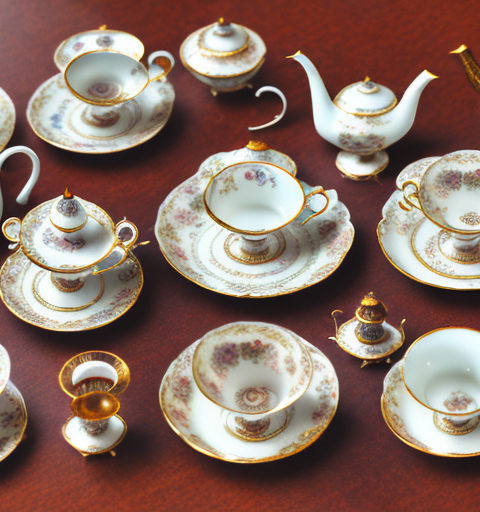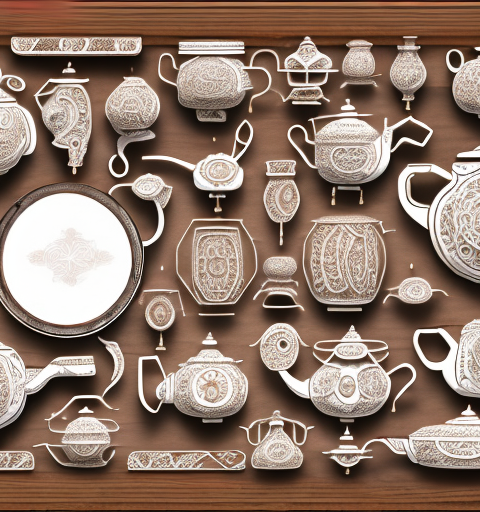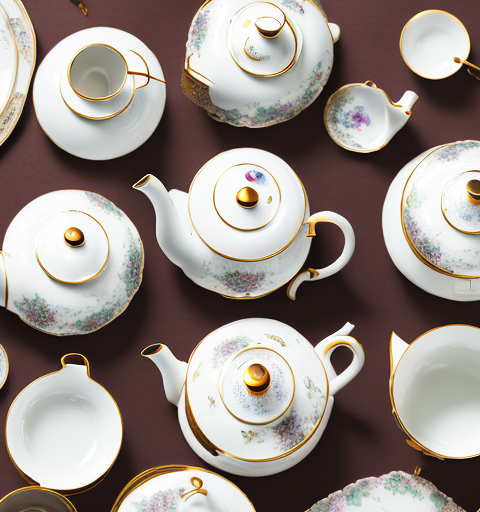Understanding the cause of tea stains on ceramic lids with silicone seals
Tea stains on ceramic lids with silicone seals are a common problem faced by tea enthusiasts. These stains occur due to the tannins present in tea leaves, which have a tendency to adhere to surfaces and leave behind unsightly marks. The combination of the porous nature of ceramic and the presence of a silicone seal on the lid creates the perfect conditions for tea stains to develop.
The silicone seal, although designed to provide an airtight seal and prevent leaking, can attract and trap tea particles, making cleaning even more challenging. It is important to understand the cause of tea stains on ceramic lids with silicone seals in order to effectively remove them and maintain a clean teapot lid.
One way to prevent tea stains on ceramic lids with silicone seals is to regularly clean and dry the lid after each use. This helps to remove any residual tea particles that may have accumulated on the surface. Additionally, using a gentle cleaning solution specifically designed for ceramic surfaces can help to break down and remove stubborn tea stains. It is also important to avoid using abrasive scrubbers or harsh chemicals, as these can damage the ceramic and silicone materials. By taking proper care of your teapot lid, you can enjoy a stain-free and visually appealing tea-drinking experience.
The importance of maintaining a clean teapot lid
A clean teapot lid is essential not only for aesthetic reasons but also for maintaining the taste and quality of your brewed tea. Tea stains not only make your teapot lid look unsightly, but they can also impact the flavor of your tea. Residual tea particles can affect the infusion process and alter the taste of subsequent brews.
Furthermore, neglecting to clean your teapot lid can lead to the growth of mold or bacteria, compromising your health and wellbeing. Regular cleaning of your ceramic lid with a silicone seal is crucial to ensure a hygienic and enjoyable tea-drinking experience.
In addition to maintaining the taste and quality of your tea, a clean teapot lid also helps to prolong the lifespan of your teapot. Tea stains and residue can gradually build up on the lid, causing it to become discolored and potentially affecting its functionality. Regular cleaning and care of your teapot lid can help to prevent these issues and ensure that your teapot remains in good condition for years to come.
Simple steps to prevent tea stains on ceramic lids with silicone seals
Prevention is always better than cure when it comes to tea stains on ceramic lids with silicone seals. By following a few simple steps, you can minimize the chances of tea stains developing in the first place.
Firstly, it is advisable to rinse your teapot lid immediately after use. This removes any tea particles that may have accumulated on the surface before they have a chance to dry and leave stains. Use warm water and a soft sponge to gently wipe away any residue.
Secondly, it is recommended to periodically deep clean your teapot lid. This involves disassembling the silicone seal and thoroughly cleaning both the ceramic lid and the seal. This ensures that any hidden tea stains are removed and prevents the buildup of tea particles that can lead to stains over time.
Additionally, it is important to avoid using abrasive cleaners or scrub brushes on the ceramic lid and silicone seal. These can cause scratches and damage the surface, making it more prone to staining. Instead, opt for gentle cleaning methods to preserve the integrity of the lid and seal.
Identifying the type of tea stain on your teapot lid
Before diving into the various cleaning methods, it is important to identify the type of tea stain on your teapot lid. The nature of the stain plays a significant role in determining the most effective cleaning approach.
Tea stains can range from light discoloration to dark, stubborn marks. Light stains may be relatively easy to remove with simple cleaning methods, while darker stains may require more intensive treatment. By understanding the type of tea stain, you can select the appropriate cleaning method and achieve the best results.
One common type of tea stain is caused by tannins, which are naturally occurring compounds found in tea leaves. Tannin stains tend to be brown or yellow in color and can be quite stubborn. They often require a more aggressive cleaning approach, such as using a specialized stain remover or soaking the lid in a mixture of vinegar and water.
In addition to tannin stains, tea stains can also be caused by other substances, such as sugar or milk. These stains may appear sticky or greasy and can be more challenging to remove. To tackle these types of stains, it is recommended to use a gentle cleanser or dish soap and scrub the lid with a soft brush or sponge.
Natural remedies for removing tea stains from ceramic lids
If you prefer to use natural remedies, there are several options available for removing tea stains from ceramic lids. Lemon juice is a highly effective natural stain remover. Its acidic properties help break down the tannins and lift the stains from the surface. Apply fresh lemon juice to a cloth or sponge and gently scrub the stained areas. Rinse thoroughly with warm water afterwards.
Baking soda is another natural remedy that can be used to remove tea stains. Create a paste by mixing baking soda with water and apply it to the stains. Allow it to sit for a few minutes before gently scrubbing with a soft brush or sponge. Rinse well to remove any residue.
Vinegar is yet another natural option for stain removal. White vinegar can be used in a similar manner to lemon juice. Soak a cloth or sponge in vinegar and gently scrub the stained areas. Rinse thoroughly afterwards.
Another natural remedy for removing tea stains from ceramic lids is hydrogen peroxide. Its bleaching properties can help lighten and remove stubborn stains. Apply hydrogen peroxide directly to the stained areas and let it sit for a few minutes. Gently scrub with a cloth or sponge and rinse well.
If you prefer a more abrasive natural remedy, you can try using salt. Salt acts as a gentle abrasive that can help scrub away tea stains. Sprinkle salt directly onto the stains and use a damp cloth or sponge to scrub in a circular motion. Rinse thoroughly to remove any salt residue.
Using household products to remove tea stains from ceramic lids
If you prefer to use household products for stain removal, there are several options available that are likely already in your pantry or cleaning cabinet.
Dish soap is a versatile cleaner that can effectively tackle tea stains. Apply a small amount of dish soap to a sponge or brush and gently scrub the stains. Rinse thoroughly with warm water to remove any residue.
Baking soda, in addition to being a natural remedy, can also be used as a household cleaner. Sprinkle baking soda onto a damp sponge or cloth and gently scrub the stained areas. Rinse well afterwards.
Hydrogen peroxide is another household product that can be used for stain removal. Apply a small amount to a cloth or sponge and gently rub the stained areas. Rinse thoroughly afterwards to remove any residue.
Vinegar is a common household product that can also be used to remove tea stains from ceramic lids. Mix equal parts vinegar and water in a spray bottle and spray the solution onto the stained areas. Let it sit for a few minutes, then scrub with a sponge or brush. Rinse well with warm water.
Lemon juice is another natural remedy that can effectively remove tea stains. Squeeze fresh lemon juice onto a cloth or sponge and gently rub the stained areas. Let it sit for a few minutes, then rinse thoroughly with warm water.
Step-by-step guide to removing tea stains from a ceramic lid with a silicone seal
Removing tea stains from a ceramic lid with a silicone seal requires a systematic approach to ensure thorough cleaning.
Step 1: Disassemble the teapot lid by removing the silicone seal if possible. This will allow better access to the stained areas.
Step 2: Rinse the lid with warm water to remove any loose tea particles or residue. This will make the subsequent cleaning process more effective.
Step 3: Choose your preferred cleaning method from either the natural remedies or household products mentioned earlier. Apply the chosen cleaner to a cloth or sponge and gently scrub the stained areas.
Step 4: For stubborn stains, consider applying the cleaner and allowing it to sit for a few minutes before scrubbing. This will give the cleaner more time to break down the stains.
Step 5: Rinse the lid thoroughly with warm water to remove any residue from the cleaning process.
Step 6: If the lid was disassembled, carefully clean the silicone seal separately. Use warm water and a mild detergent to remove any tea particles or residue. Rinse well before reassembling the lid.
Step 7: Once the lid is clean, dry it thoroughly with a soft cloth or allow it to air dry before using or storing.
It is important to note that different types of tea stains may require different cleaning methods. For example, black tea stains may be more stubborn and require a stronger cleaning solution, while green tea stains may be easier to remove with a gentler approach. Experiment with different cleaning methods and adjust accordingly based on the type and severity of the tea stains.
Exploring commercial cleaning products for tea stain removal on teapot lids
If natural remedies or household products are not effective in removing tea stains from your teapot lid, there are several commercial cleaning products available specifically designed for stain removal.
Look for products that are safe for use on ceramic surfaces and follow the manufacturer’s instructions for application. These products often have powerful stain-fighting ingredients that can effectively tackle even the toughest tea stains.
It is important to note that these commercial cleaning products may contain chemicals, so be sure to handle them with care and follow any safety guidelines provided.
Tips for maintaining a stain-free teapot lid with a silicone seal
Maintaining a stain-free teapot lid with a silicone seal requires regular care and attention. By incorporating a few simple tips into your tea brewing routine, you can prevent tea stains and keep your teapot lid looking pristine.
Firstly, avoid letting brewed tea sit in the teapot for an extended period of time. The longer the tea remains in contact with the lid, the higher the chances of stains developing. Pour out any excess tea and rinse the lid immediately after use to remove any residual tea particles.
Secondly, regularly clean the teapot lid, including the silicone seal, by following the step-by-step guide mentioned above. This will remove any tea stains before they have a chance to become stubborn and difficult to remove.
Lastly, consider using a separate lid or cover to protect your teapot lid when not in use. This can prevent dust, dirt, and other substances from coming into contact with the lid and potentially causing stains.
Troubleshooting common issues when removing tea stains from ceramic lids
While removing tea stains from ceramic lids with silicone seals is generally a straightforward process, there are a few common issues that may arise during the cleaning process.
If you encounter stubborn stains that do not respond to the chosen cleaning method, consider repeating the process or trying an alternative cleaning method. In some cases, perseverance and patience may be necessary to achieve satisfactory results.
If disassembling the teapot lid is not possible or proves difficult, try using a brush or toothbrush with soft bristles to clean hard-to-reach areas. Ensure that the bristles are gentle enough to avoid scratching the ceramic surface.
If the silicone seal becomes damaged or worn over time, it may be necessary to replace it. Damaged seals can harbor tea particles and make cleaning more challenging. Contact the teapot manufacturer or look for replacement seals online.
Understanding the role of silicone seals in preventing tea stains on teapot lids
Silicone seals play a crucial role in preventing tea stains from developing on teapot lids. The airtight seal created by the silicone prevents tea from dripping or leaking through the lid during use.
However, due to the nature of silicone, it can attract and trap tea particles, resulting in stains over time. Regular cleaning of the silicone seal is essential to prevent the buildup of tea particles and maintain its functionality.
Additionally, silicone seals can deteriorate over time or become damaged. It is important to inspect the seal regularly and replace it if necessary to ensure proper functionality and prevent tea stains from developing.
How to properly clean and care for your teapot lid with a silicone seal
To properly clean and care for your teapot lid with a silicone seal, follow these steps:
1. Regularly rinse the lid with warm water immediately after use to remove any residual tea particles.
2. Periodically disassemble the teapot lid and clean all parts, including the silicone seal, with warm water and a gentle detergent.
3. Gently scrub the lid and silicone seal with a soft brush or sponge to remove any stains or residue.
4. Rinse the lid and silicone seal thoroughly with warm water to ensure all cleaning agents are removed.
5. Dry the lid and silicone seal completely before reassembling and storing to prevent the growth of mold or bacteria.
By following these steps, you can ensure that your teapot lid with a silicone seal remains clean, stain-free, and functional for years to come.
Expert recommendations for tackling stubborn tea stains on ceramic lids
If you are faced with stubborn tea stains on your ceramic lid, these expert recommendations can prove helpful in removing them.
1. Utilize a combination of cleaning methods. For example, start with a natural remedy such as lemon juice or vinegar, followed by a household cleaner like dish soap or baking soda if needed. This multi-step approach can enhance the effectiveness of the cleaning process.
2. Consider using a specialized ceramic cleaning product specifically designed for stain removal. These products often contain enzymes or other active ingredients that can break down tough tea stains.
3. Apply more pressure when scrubbing stubborn stains, but be cautious not to damage the ceramic surface. Use a gentle yet firm touch to remove the stains without causing any harm.
Following these expert recommendations can greatly increase the likelihood of successfully removing stubborn tea stains from your ceramic lid.
Exploring alternative cleaning methods for tea stain removal on teapot lids
If you are looking for alternative cleaning methods to remove tea stains from your teapot lid, there are a few unconventional approaches you can try.
One alternative method involves using denture cleaning tablets. Dissolve a denture cleaning tablet in warm water and soak the lid in the solution for a few hours or overnight. The effervescent action of the tablet can help loosen and lift tea stains. Rinse the lid thoroughly afterwards.
Another alternative method is to create a paste using cream of tartar and hydrogen peroxide. Apply the paste to the tea stains and allow it to sit for some time before gently scrubbing with a soft brush or sponge. Rinse well to remove any residue.
While these alternative methods may not be as widely known or extensively researched as traditional cleaning methods, they can be worth exploring if you are open to trying something different.






